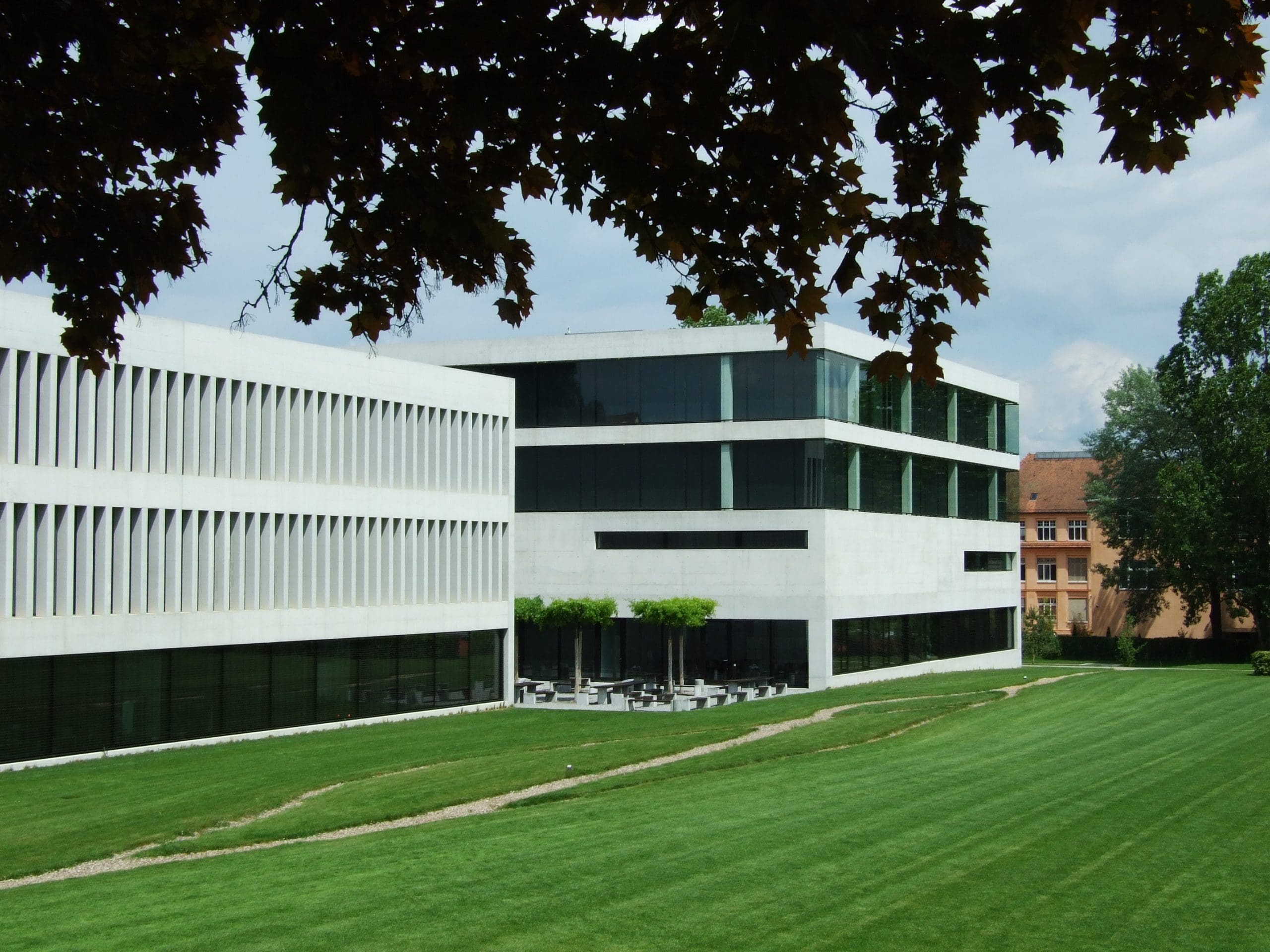
The discussion of robotic mowers has been a hot topic for years, but mostly the focus has been on its application in residential spaces. However, multiple brands have been working on creating autonomous mowers that can be utilized on commercial properties.
Each manufacturer has approached the equation of robotic mowers with a slightly different solution, so we’re breaking down how the technology works for each featured brand.
Greenzie
Greenzie’s solution four years ago was to create autonomous software, rather than hardware. The company is branded as cutting-edge software for commercial mowers. This is because Charles Brian Quinn, co-founder and CEO of Greenzie, opted to partner with original equipment manufacturers (OEMs) like Wright Manufacturing, Bobcat, Scag and Mean Green Mowers.
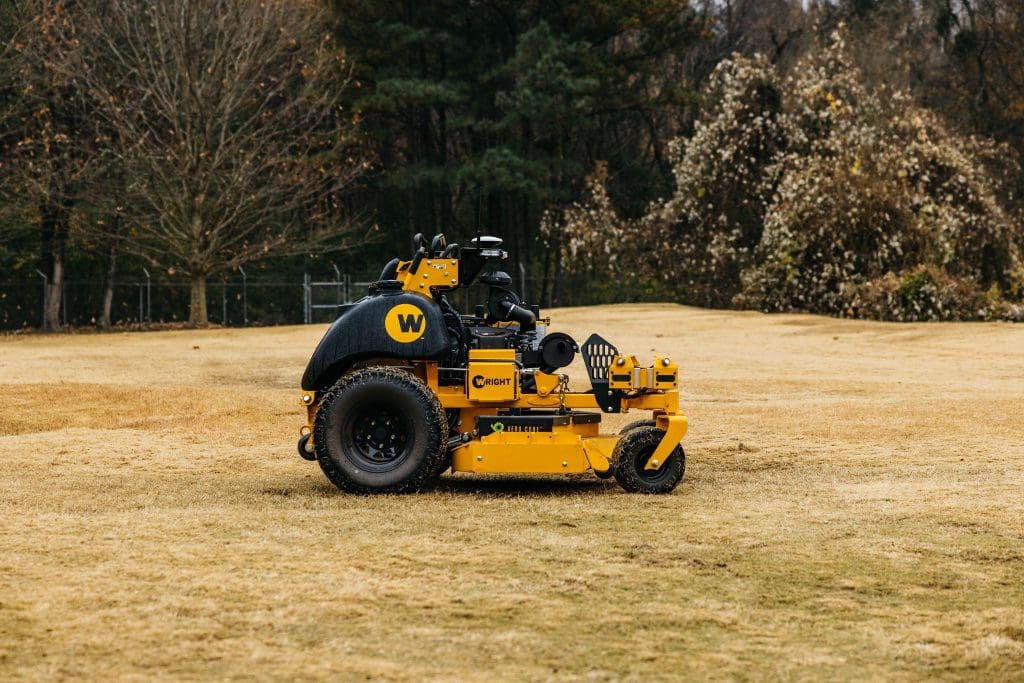
“What that means is, we don’t produce a mower,” Quinn says. “You’re not going find a Greenzie branded mower. We’re not out there trying to reinvent the wheel, literally or figuratively, as it were. The way our technology works is that we work with the manufacturers, so we add the robotic sensors that enable autonomy at the factory, which is very critical. We work in concert with the OEMs.”
Quinn made this choice after talking to landscapers of all sizes.
“When I asked them what would you want? If you could wave a magic wand, they said, ‘I just want autopilot on my mowers,’” Quinn says.
He quickly found that retrofitting mowers with autonomous technology would void the machine’s warranty, so by working with OEMs, the mowers can be outfitted with the necessary technology on the assembly line. Greenzie can be electric or gas-powered, depending on the model you buy from OEMs.
“Our goal is to make autonomous mowing an industry standard,” Quinn says. “Briggs & Stratton makes engines for every mower. We want to be a partner to the OEMs and give them a reliable part that their customers are asking for and that is software that enables their mower to mow autonomously. A robotic worker on every mower.”
Quinn likens their software to Sirius XM radio that has to be activated in a car. Mowers with Greenzie’s technology can be used autonomously or manually.
With Greenzie’s software, a crew member will mow the perimeter with a Greenzie-activated mower and then they can set the mower to autonomously mow inside of that perimeter. The crew would remain on-site handling other work.
Quinn says in some cases, crews will finish their work and hop on another mower and meet the autonomous mower halfway, getting done twice as fast.
“They’re getting real return on investment on a robotic worker that never gets tired, never complains and just loves mowing,” Quinn says.
Husqvarna
Husqvarna has been pioneering in the robotic mowing space since 1995. CEORA is the company’s autonomous solution for commercial turf management, which launched officially this year.
“It enjoyed a successful soft launch in 2022 which included successful utilization on NA golf courses, public spaces and even baseball fields,” says Jason Connor, director of commercial robotics for Husqvarna.
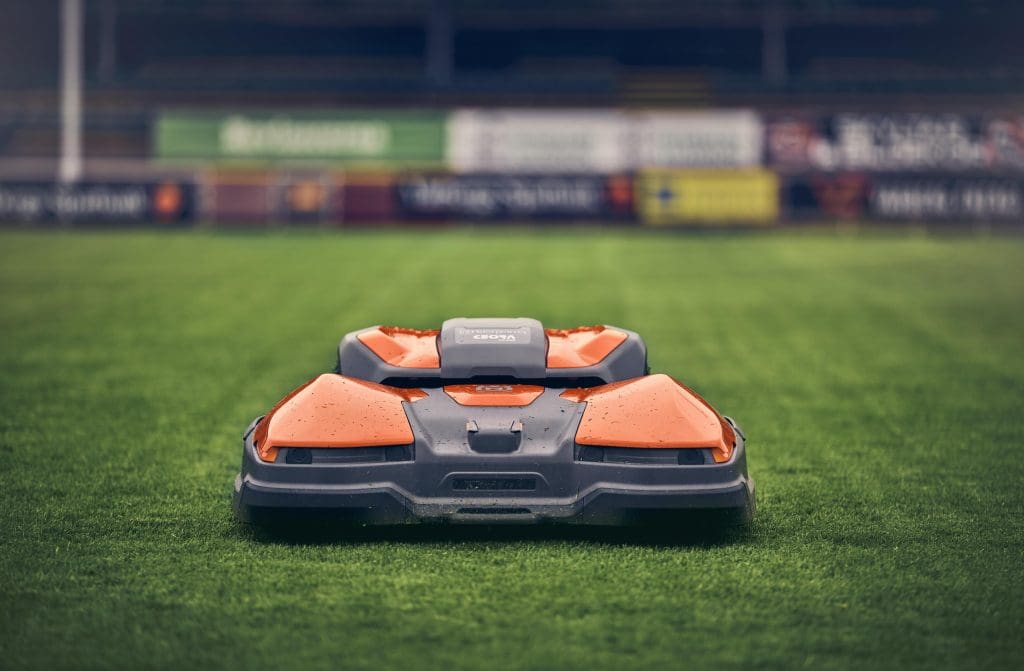
CEORA utilizes EPOS (exact positioning operating system), boundary wire-free, satellite-based technology to mow up to 16 acres with a regular quality cut. EPOS uses high-precision satellite signals to create virtual boundaries. It has a 26.8 cutting width and can cut up to 2.8-inch-high grass. Like Husqvarna’s residential Automowers, CEORA keeps grass freshly cut 24/7. It is an electric model that recharges itself as needed.
“An Automower’s razor-sharp, small blades cut grass a little at a time, more often, on a schedule the user sets based on operation and lawn needs,” Connor says. “Additionally, the tiny clippings an Automower produces – which act as a continuous, lawn beautifying ‘micro-mulch’ – are recycled into the turf as natural fertilizer faster and more efficiently. Ready to be programmed as needed and work on their own, Automowers have built-in sensors which adjust and react to grass growth, weather conditions and tricky area terrain.”
Users can monitor and control multiple mowers through Husqvarna’s Fleet Services from their smartphone, tablet or laptop. The mower can also be moved remotely through appDrive to move the product from one area to another without carrying. Users can set temporary stay-out zones to keep the robot from working in part of the property.
“We see robotic mowing as the future of both residential and commercial lawn care,” Connor says. “Husqvarna’s Automowers have gained widespread acceptance and market volume in many markets around the globe, and we expect these trends to continue to largely impact North America as well. As more focus is placed on battery-powered solutions and sustainability, Husqvarna continues to innovate here.”
Scythe
Scythe’s solution for an autonomous mower was to build from the ground up, designing the mechanical, electrical systems and software rather than retrofitting things to accommodate the sensors.
“What you get as a result is just you get a lot tighter control,” says Billy Otteman, director of marketing for Scythe. “We have a very great interaction between the hardware and software systems so the system can identify an obstacle and stop faster or it can perform and mow better on a slope because it’s using all of the software analysis, the assessment of the environment, to be able to get those laser straight stripes on a slope and use the traction control that we have on our machine as the result of being fully integrated.”
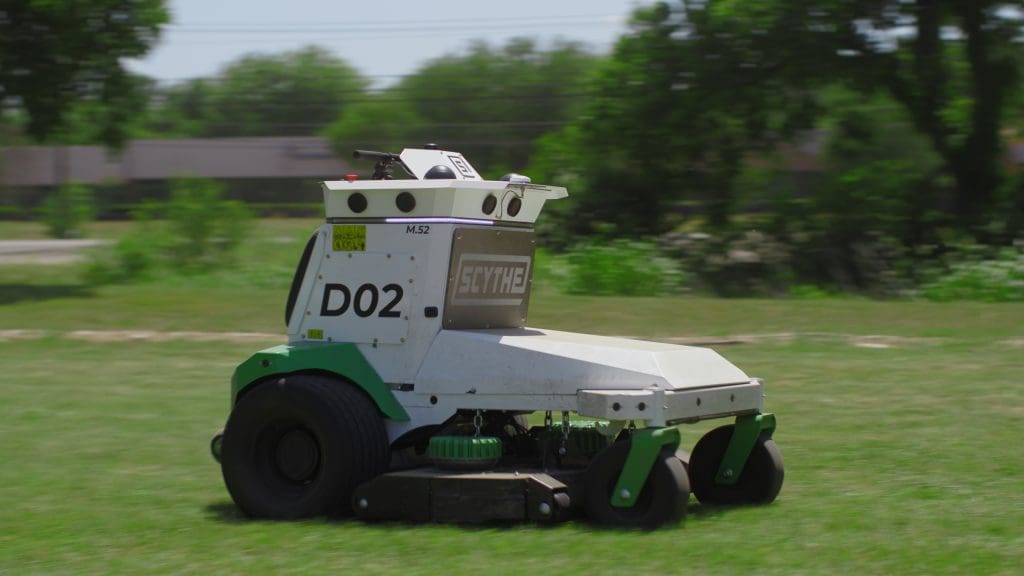
The primary sensing system for the robot is computer vision, which they have dubbed Scythe Sight. The machine uses HDR cameras along with other sensors like GPS and ultrasonics to identify and respond to different obstacles it comes across. The computer uses artificial intelligence to tell the difference between a tree or a pole and a human or an animal. It knows to go around objects like trees or poles, but it will stop for a human or an animal.
Designed as a stand-on mower, you can use a Scythe mower autonomously or manually. Similar to Greenzie, you mow the perimeter one time before setting the robot to mow.
“Say it’s corporate campus A, you mow the perimeter of the area you want to mow, and then you just set it to Scythe mode and it starts laying stripes on its own,” Otteman says. “It’s able to identify all the obstacles within that perimeter as it goes.”
The mower knows where it is on a property, so it pulls up the perimeter of the correct location. Otteman says if a corporate campus is particularly large, you can categorize the perimeters and it’ll know which of these to use.
“The best part is as that computer vision works, say week to week something has changed, maybe some new trees have been planted within that perimeter, the perimeter is saved, and then as the robot goes, it will respond to whatever obstacles are inside of it,” Otteman says. “It remembers where different obstacles are, but if something new comes up, it will move around it and rechart its path for next time and moving forward.”
Otteman says it can mow one to two acres an hour, depending on the complexity of site and how often the mower is stopping due to people walking by. Scythe’s mower is electric and they have optimized the machine for electrical power with a patent-pending deck and blade system that allows the machine to conserve power and get a high-quality cut while using less energy. He says with traditional gas models a significant amount of power simply goes to moving air to lift the grass up to cut it.
“Being able to have an energy consumption system designed to really optimize is one of the things that we focus very closely on that the industry or other OEMs haven’t really looked at in the past,” Otteman says. “When you have gas power, you have an easily accessible power source, so you don’t have to worry about conserving power.”
He says they are continually working to increase their battery capacity and battery lifetime. He expects as advancements continue in electric vehicles, those will trickle down to the landscape industry.
Zapt
Like Scythe, Zapt also decided to build their mower from the ground up but went with a design that moves even further the traditional zero-turn mower silhouette.
“To provide the most productive autonomous mower, we needed maneuverability that exceeds the capabilities of a zero-turn mower,” Keith Vickery, president of Zupt, LLC, the parent company of Zapt. “While a zero-turn is an excellent platform for a self-driving mower and removes some obstacles to technology adoption because of familiarity, the platform also has slope and turn issues that limit the potential mow patterns and use cases.”
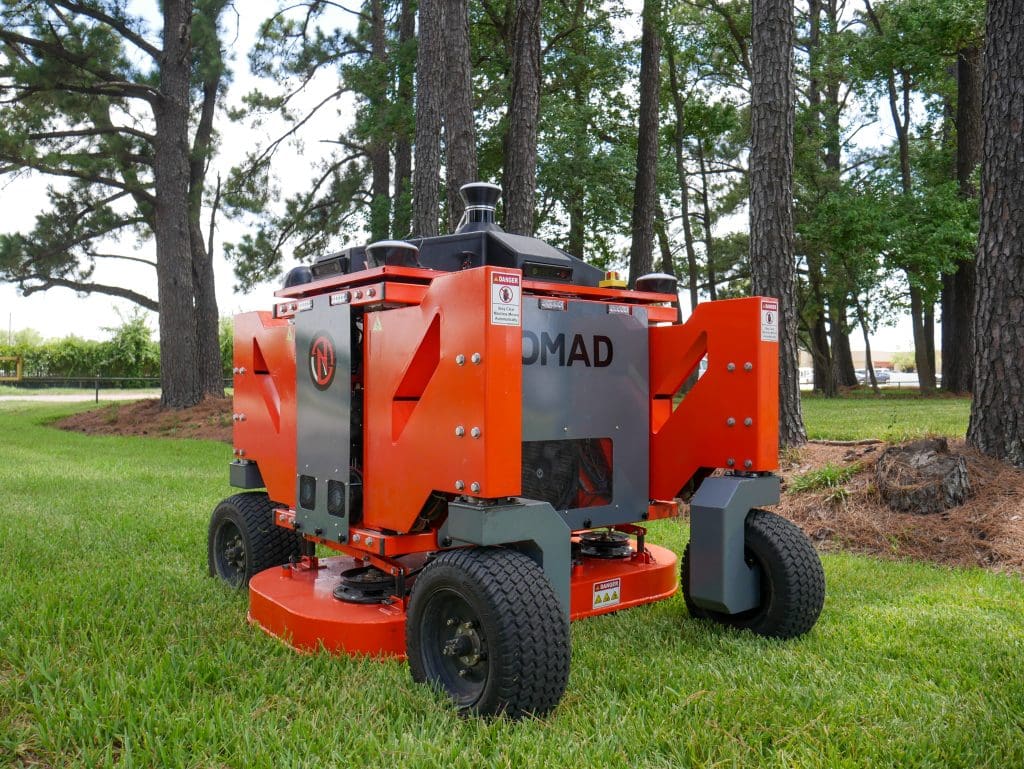
Nomad is their autonomous mower and it can turn and traverse slopes differently than a zero-turn. It has fat and skinny modes, with the mower being 60 inches wide in fat mode and 36 inches wide in skinny mode.
Vickery adds that building from scratch also gives them complete control over their senor integration, algorithms and data management.
Nomad uses multiple GNSS receivers, a 360° LiDAR system, four stereo cameras on each face of the mower, as well as inertial navigation sensors, resolvers for steering and traction, and ultrasonic sensors to allow it to operate freely in its environment.
“When you talk about safety and reliability and everything else, you really need to be using a GNSS receiver instead of a GPS receiver, because you’ve got a whole bunch more redundancy in the information you’re getting out of a GNSS solution,” Vickery says.
Operators use satellite imagery to determine the mowing zone through geofencing with an outer bounding polygon that prohibits the mower from leaving the designated area. Multiple paths are generated within the space so the mower cuts as efficiently as possible within the space.
“When working on the path, the mower constantly evaluates its position (localization) and the environment it is sensing around it (perception) with input from the array of sensors onboard,” Vickery says. “This constant data stream allows the navigation engine to keep the unit operating within the established boundaries while sensing any obstructions or unknown objects in its path.”
When GNSS is unavailable, localization remains possible with LiDAR map matching techniques combined with camera imagery coupled to the Inertial Measurement Unit (IMU). This solution provides steering and velocity commands to the mower.
Nomad is powered by a 38-hp gas engine with a six-gallon fuel tank. Vickery says it can mow between three to four acres an hour, depending on the project. He says between the question of increased weight with battery packs and the technology not being there yet, they decided to create a gas-powered model.
“We believe that to gain entrance to the marketplace if we put a gas engine on there and deal with the autonomous learning bit, the commercial contractors are currently comfortable with that,” Vickery says. “They know it’s going to last four to five hours. It’s autonomous so it can go back to where you can tip more gas into it. They just get it that it will last all day for them.”
Unlike some of the other commercial autonomous mowers, Nomad cannot be driven manually. They opted not to have a seat because of the added heigh and weight to the mower.
“We looked at the problem and we said, ‘I want the most efficient platform that I can end up with that will give me very productive mowing and a lot of control in all situations we think we’re going to find,’ and we decided that was four-wheel steer, four-wheel drive,’” Vickery says. “If you try to fit autonomy into a platform that was designed for humans, you’re limiting the ability of the autonomy is our philosophy.”

